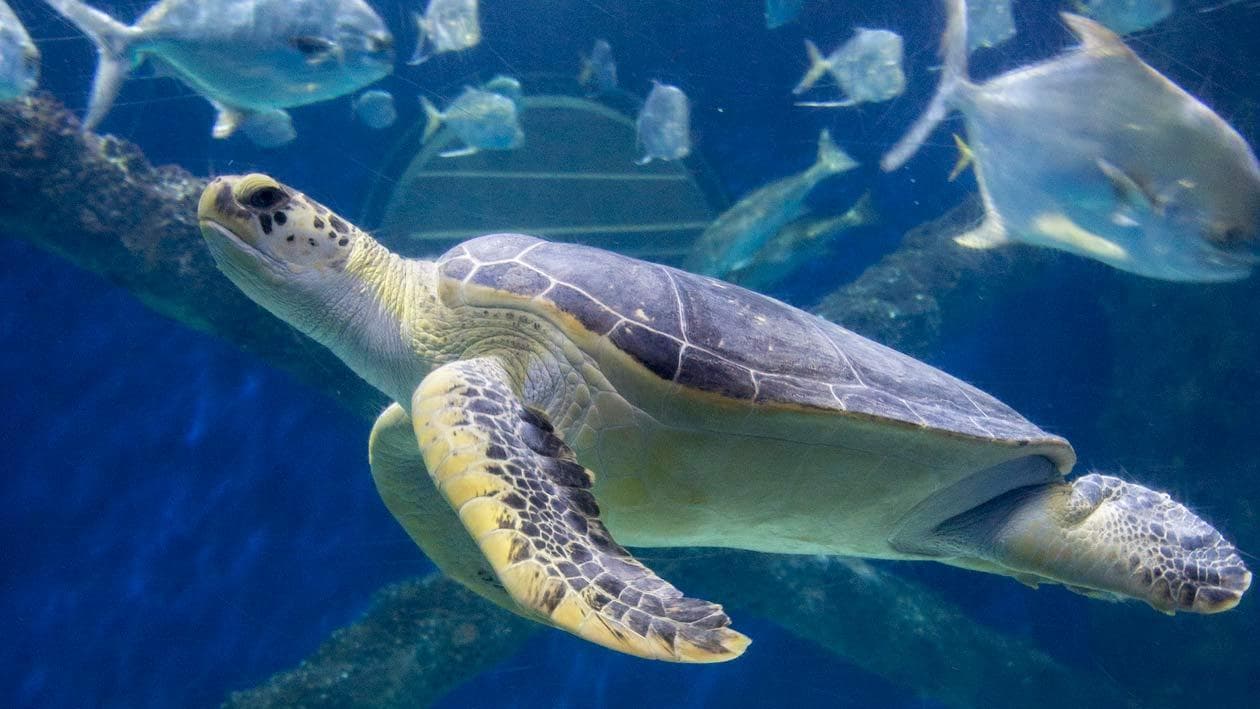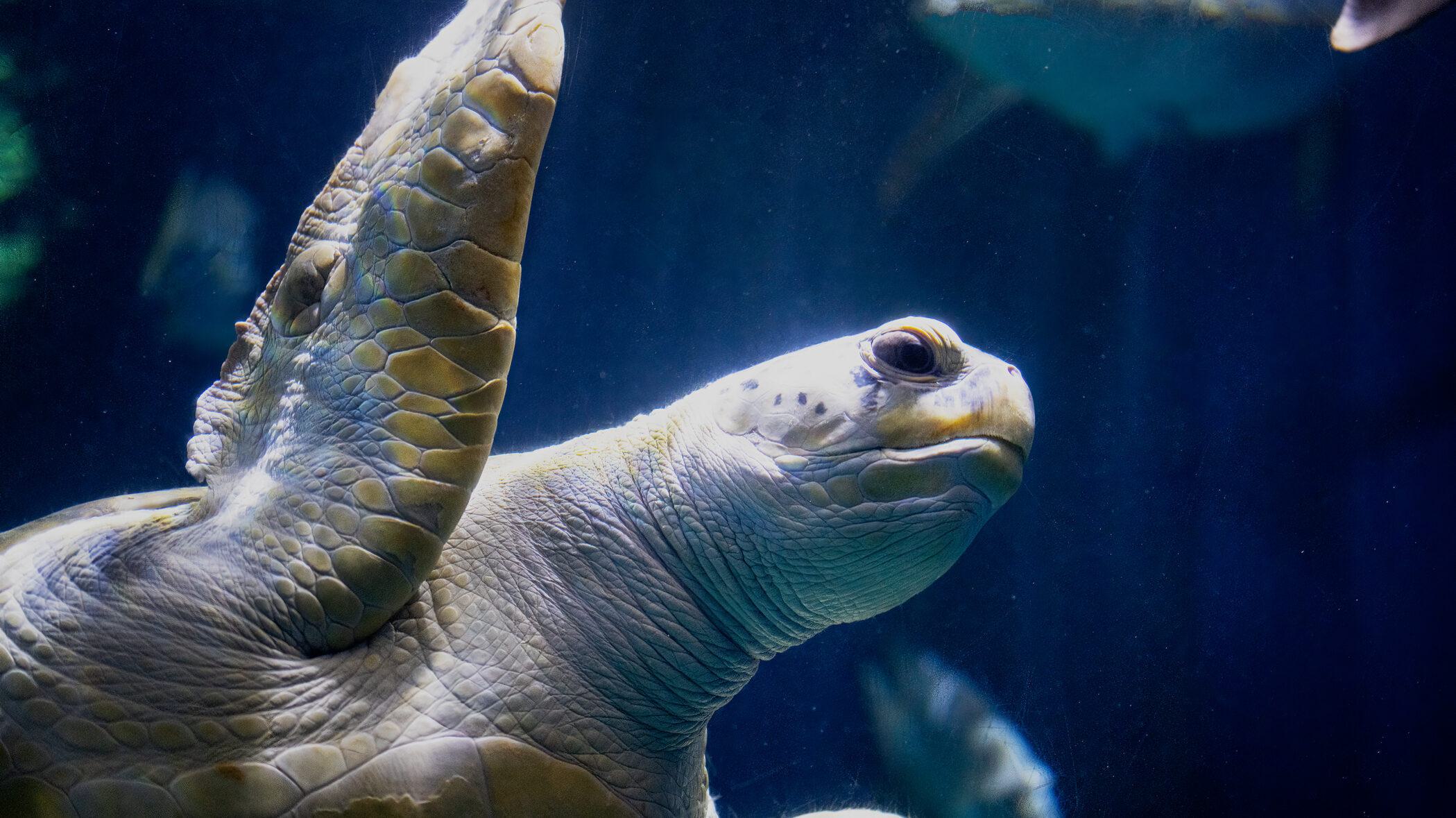Length: up to 4 feet
Weight: up to 440 pounds
Unlike their semi-aquatic or terrestrial relatives, sea turtles have flippers in place of legs. Each front flipper has a single claw. Ironically, green turtle shells (carapaces) are not green. The carapace of an adult green turtle is smooth and light to dark brown with dark markings, with a lighter, whitish to light yellow plastron. It is the turtle's cartilage and body fat that is green due to their diet.
Scutes
A turtle's shell is comprised of large, hard scales called scutes. Like human fingernails, scutes are made from keratin and they grow as the turtle grows. Green turtles can be identified by having four pairs of scutes along the sides that do not border the scute on the neck, and have one pair of scutes between the eyes.
Did you know?
A turtle is one of the few animals that has both an internal and external skeleton. Its upper, or dorsal, heart-shaped carapace attaches to the lower, ventral shell (plastron) on the turtle's side at a series of bridges. The shell structure is akin to a human rib cage and is comprised of broad fused ribs, which protect the internal organs.
Diet
During their first year of life, green turtles feed on jellyfish, mollusks, crustaceans, and other invertebrates until they reach 8-10 inches in length. Adults are primarily herbivorous, feeding on seagrass and algae that gives their body fat and cartilage its characteristic green color.
Habitat
Green turtles live all over the world, nest in over 80 countries, and live in the coastal areas of more than 140 countries. They are found mainly in tropical and subtropical waters, and like other sea turtles, migrate long distances between feeding areas and the beaches from where they hatched.
Social Behavior
Green turtles are considered solitary animals, but are known to occasionally congregate to feed in areas with abundant algae and seagrasses.
Reproductive Behavior
Unlike their semi-aquatic or terrestrial relatives, sea turtles come ashore only to lay their eggs, though the males arrive at the waters just offshore and wait for the females. While males can breed annually, females breed only every 3 to 4 years. After mating, the female will come onto the beach to establish a nest. Females use their single front claws to help anchor themselves while using their back flippers to dig their nest burrows in the sand, then deposit 75 to 200 eggs into the hole and cover them with sand. At this point, the mother turtle considers her job complete and she leaves the nest. She will repeat the process. laying several clutches before leaving the nesting beach. Although they try to establish nests in unpopulated areas along shorelines that slope back to the ocean, survivability is not guaranteed.
The eggs will hatch after about two months. The young hatchlings must make their way to the water, and it is at this time that these turtles are susceptible to predators and other dangers. Even hatchlings that make it to the water are not safe from predators such as sea birds and marine mammals. Survival estimates range, but on average, it is believed that fewer than 1 in every thousand sea turtles reaches maturity.
Sea turtles that survive these early weeks spend most of their time feeding and growing out in the ocean. They do not reach sexual maturity until they are between 20 and 50 years of age, but they are expected to live for decades beyond.
Did you know?
The sex of a hatchling is determined by the temperature in which its egg is incubated. For this reason, an entire clutch is most likely to have all hatchlings of one sex.
Celebrations
In 2025, the International Union for the Conservation of Nature recategorized the global count of green sea turtles from Endangered to Least Concern, marking a success in conservation efforts to protect this species!
Many countries, including the United States, prohibit the killing of sea turtles and the collection of their eggs. The Virginia Aquarium is dedicated to protecting and recovering green turtle populations worldwide, actively researching and using a variety of innovative techniques to study, protect, and recover these endangered animals. Visit our Conservation In Action page to learn more about the important work we are doing to help protect green turtles and other sea turtle species.
Concerns
Green turtles are widespread across the world's oceans, but were once considered threatened or endangered in every population group worldwide, and remain so in certain regions.
Their primary threats are from human impact. Historically, green turtles were captured for their fat, meat, and eggs, which led to global population decline. They are also frequently caught as bycatch in commercial fishing, become entangled in recreational fishing gear, or ingest marine debris. They are frequent victims of vessel strikes as well. Habitat loss where they nest and forage has also factored into their decline. Though prohibited in many countries, illegal killing for their meat and shells continues today in wildlife trafficking rings. Global warming has also increased severe weather incidents that in turn destroy important nesting sites.



